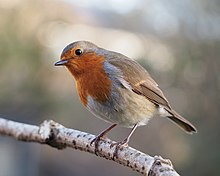Telluraves
| Telluraves | |
|---|---|

| |
| European robin, Erithacus rubecula | |
| Scientific classification | |
| Domain: | Eukaryota |
| Kingdom: | Animalia |
| Phylum: | Chordata |
| Class: | Aves |
| Clade: | Neoaves |
| Clade: | Passerea |
| Clade: | Telluraves Yuri et al., 2013 |
| Clades | |
Telluraves (also called land birds or core landbirds) is a recently defined[2] clade of birds defined by their arboreality.[3] Based on most recent genetic studies, the clade unites a variety of bird groups, including the australavians (passerines, parrots, seriemas, and falcons) as well as the afroavians (including the Accipitrimorphae – eagles, hawks, buzzards, vultures etc. – owls and woodpeckers, among others).[4] They appear to be the sister group of the Ardeae.[5]
Given that the most basal extant members of both Afroaves (Accipitrimorphae, Strigiformes) and Australaves (Cariamiformes, Falconiformes) are carnivorous, it has been suggested that the last common ancestor of all Telluraves was probably a predator.[5] Other researchers are skeptical of this assessment, citing the herbivorous cariamiform Strigogyps as evidence to the contrary.[6]
Afroaves has not always been recovered as a monophyletic clade in subsequent studies.[7] For instance, Prum et al. (2015) recovered the accipitrimorphs as the sister group to a clade (Eutelluraves) comprising the remaining Afroavian orders and Australaves.,[8] while an analysis by Houde et al. (2019) recovered a clade of accipitrimorphs and owls as sister to the remaining landbirds.[9]
| Telluraves |
| ||||||||||||||||||||||||||||||||||||||||||||||||||||||||||||||||||
Cladogram of Telluraves relationships based on Braun & Kimball (2021)[10]
References
- ^ Daniel T. Ksepka; Thomas A. Stidham; Thomas E. Williamson (2017). "Early Paleocene landbird supports rapid phylogenetic and morphological diversification of crown birds after the K–Pg mass extinction". Proceedings of the National Academy of Sciences of the United States of America. 114 (30): 8047–8052. Bibcode:2017PNAS..114.8047K. doi:10.1073/pnas.1700188114. PMC 5544281. PMID 28696285.
- ^ Yuri, T.; Kimball, R.T.; Harshman, J.; Bowie, R.C.K.; Braun, M.J.; Chojnowski, J.L.; Han, K.-L.; Hackett, S.J.; Huddleston, C.J.; Moore, W.S.; Reddy, S.; Sheldon, F.H.; Steadman, D.W.; Witt, C.C.; Braun, E.L. (2013). "Parsimony and model-based analyses of indels in avian nuclear genes reveal congruent and incongruent phylogenetic signals". Biology. 2 (1): 419–444. doi:10.3390/biology2010419.
- ^ Crouch, N.M.A.; Ramanauskas, K.; Igić, B. (2019). "Tip-dating and the origin of Telluraves". Molecular Phylogenetics and Evolution. 131: 55–63. doi:10.1016/j.ympev.2018.10.006.
- ^ Ericson, P. G. (2012). "Evolution of terrestrial birds in three continents: biogeography and parallel radiations" (PDF). Journal of Biogeography. 39 (5): 813–824. doi:10.1111/j.1365-2699.2011.02650.x. Archived from the original (PDF) on 2017-08-30.
- ^ a b Jarvis, E. D.; Mirarab, S.; Aberer, A. J.; Li, B.; Houde, P.; Li, C.; Ho, S. Y. W.; Faircloth, B. C.; Nabholz, B.; Howard, J. T.; Suh, A.; Weber, C. C.; Da Fonseca, R. R.; Li, J.; Zhang, F.; Li, H.; Zhou, L.; Narula, N.; Liu, L.; Ganapathy, G.; Boussau, B.; Bayzid, M. S.; Zavidovych, V.; Subramanian, S.; Gabaldon, T.; Capella-Gutierrez, S.; Huerta-Cepas, J.; Rekepalli, B.; Munch, K.; et al. (2014). "Whole-genome analyses resolve early branches in the tree of life of modern birds" (PDF). Science. 346 (6215): 1320–1331. Bibcode:2014Sci...346.1320J. doi:10.1126/science.1253451. hdl:10072/67425. PMC 4405904. PMID 25504713.
- ^ Mayr, Gerald; Richter, Gotthard (2011). "Exceptionally preserved plant parenchyma in the digestive tract indicates a herbivorous diet in the Middle Eocene bird Strigogyps sapea (Ameghinornithidae)". Paläontologische Zeitschrift. 85 (3): 303–307. doi:10.1007/s12542-010-0094-5. S2CID 84479974.
- ^ Kuhl., H.; Frankl-Vilches, C.; Bakker, A.; Mayr, G.; Nikolaus, G.; Boerno, S. T.; Klages, S.; Timmermann, B.; Gahr, M. (2020). "An unbiased molecular approach using 3'-UTRs resolves the avian family-level tree of life". Molecular Biology and Evolution. 38: 108–127. doi:10.1093/molbev/msaa191. PMC 7783168. PMID 32781465.
- ^ Prum, R.O. et al. (2015) A comprehensive phylogeny of birds (Aves) using targeted next-generation DNA sequencing. Nature 526, 569–573.
- ^ Houde, Peter; Braun, Edward L.; Narula, Nitish; Minjares, Uriel; Mirarab, Siavash (2019). "Phylogenetic signal of indels and the Neoavian radiation". Diversity. 11 (7): 108. doi:10.3390/d11070108.
- ^ Braun, Edward L.; Kimball, Rebecca T. (2021). "Data types and the phylogeny of Neoaves". Birds. 2 (1): 1–22. doi:10.3390/birds2010001.


